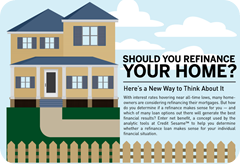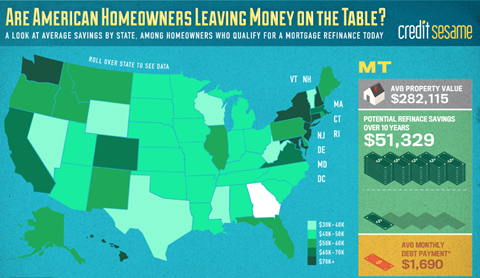 Recently, Acting Federal Housing (FHA) Commissioner Carol Galante announced significant price cuts to FHA’s Streamline Refinance Program that could benefit millions of borrowers whose mortgages are currently insured by FHA. Beginning June 11, 2012, FHA will lower its Upfront Mortgage Insurance Premium (UFMIP) to just .01 percent and reduce its annual premium to .55 percent for certain FHA borrowers.
Recently, Acting Federal Housing (FHA) Commissioner Carol Galante announced significant price cuts to FHA’s Streamline Refinance Program that could benefit millions of borrowers whose mortgages are currently insured by FHA. Beginning June 11, 2012, FHA will lower its Upfront Mortgage Insurance Premium (UFMIP) to just .01 percent and reduce its annual premium to .55 percent for certain FHA borrowers.
To qualify, borrowers must be current on their existing FHA-insured mortgages which were endorsed on or before May 31, 2009. Late last month, FHA also announced it will increase its upfront premiums on most other loans by 75 basis points to 1.75 percent. In addition, FHA will raise annual premiums 10 basis points and 35 basis points on mortgages higher than $625,500.
“This is one way that FHA can make a real difference to help homeowners who are doing the right thing, paying their bills on time and want to take advantage of today’s low interest rates,” says Galante. “By significantly reducing costs for these borrowers, we can make certain they cut their monthly mortgage burden, which will benefit the housing market and the broader economy in the process.”
Currently, 3.4 million households with loans endorsed on or before May 31, 2009, pay more than a five percent annual interest rate on their FHA-insured mortgages. By refinancing through this streamlined process, it’s estimated that the average qualified FHA-insured borrower will save approximately $3,000 a year or $250 per month. FHA’s new discounted prices assume no greater risk to its Mutual Mortgage Insurance (MMI) Fund and will allow many of these borrowers to refinance into a lower cost FHA-insured mortgage without requiring additional underwriting. FHA-insured homeowners should contact their existing lender to determine their eligibility.
Last month, the Obama Administration announced a broad package of actions and legislative proposals to help responsible homeowners save thousands of dollars through refinancing. This includes the changes announced today that will benefit current FHA borrowers—particularly those whose loan value may exceed the current value of their home. By lowering monthly mortgage costs for home-owners, FHA hopes to help more borrowers stay in their homes, thereby decreasing the potential for future default and reducing losses to the Mutual Mortgage Insurance (MMI) Fund.
The changes outlined in today’s mortgagee letter apply to all mortgages insured under FHA’s Single Family Mortgage Insurance Programs except:
- Title I
- Home Equity Conversion Mortgages (HECM)
- Section 247 (Hawaiian Homelands)
- Section 248 (Indian Reservations)
- Section 223(e) (Declining Neighborhoods)
For more information, visit www.hud.gov




